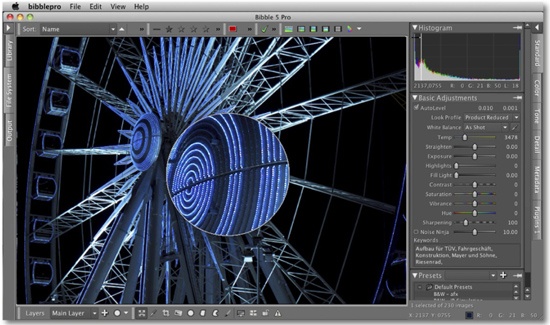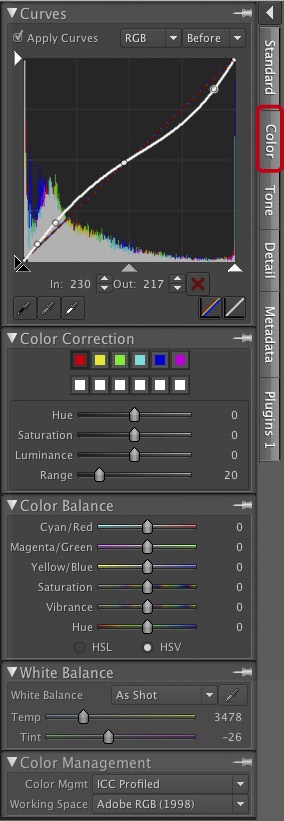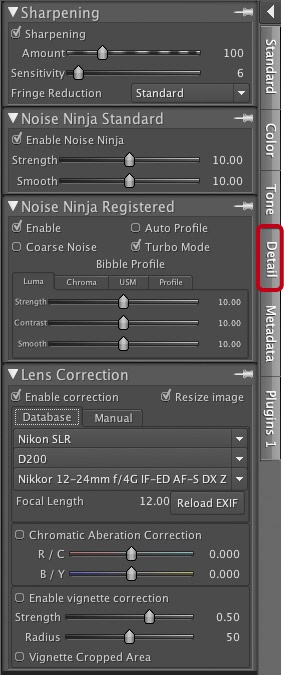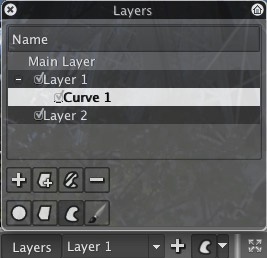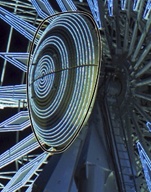The Bibble RAW editor and converter was written by Eric Hymann of Bibble Labs. The program is well established in the marketplace and is available for Mac OS X, Windows, and Linux. Bibble supports a wide range of current digital cameras. The Bibble interface is multi-language and highly configurable, with user-definable keyboard shortcuts.
Bibble 4 was generally classed as a good RAW converter, but the image management functionality built into Version 5 elevates the program to all-in-one status.
Bibble is based on a catalog concept similar to the one used by Apple Aperture and Adobe Lightroom. The Bibble Catalog is the program’s overall management container but does not have to contain the image files themselves. Bibble can manage multiple catalogs simultaneously.
As with other all-in-ones, Bibble can import images from a memory card into a newly constructed folder structure, or directly into a catalog. It can also manage images from their currently saved location.
Figure 6-57. The Bibble 5 editing window, showing the Magnifier (in the center of the Preview Panel) and the Tools Panel
Bibble can also be used purely as a RAW editor and converter. In this case, images do not have to be imported into a catalog. It is also possible to drag images from other image browsers into the Bibble window for processing. However, if you want to search through your images using metadata and other image-specific criteria, you have to import your images to the Bibble Catalog first.
Bibble supports a wide range of RAW formats as well as RGB and TIFF files. It outputs to TIFF or JPEG and only supports the RGB color mode.
Bibble’s browser is fast, functional, easy to configure, and allows the user to switch quickly and easily between different views. It reminds us a lot of Bridge in this respect. One of its great features is its ability to import metadata stored in XMP sidecar files. Bibble uses the same five-star rating and pick/reject flags as Bridge and Lightroom, and has five different color codes for labeling images.
The program’s Import module allows you to automatically rename images and to apply keywords to all imported images, but appears to be less flexible than Lightroom or Bridge. In order to simplify image browsing and management, you can arrange images in stacks.[102] Bibble also stores thumbnails for previewing images that are currently offline.
Note
![]() There are many plug-ins available for Bibble 4, some of which also work with Bibble 5. We assume that the available range will continue to expand.
There are many plug-ins available for Bibble 4, some of which also work with Bibble 5. We assume that the available range will continue to expand.
The program is fast (especially when generating previews of freshly imported images) and is constantly being expanded and updated. Bibble supports multicore computing and is supplied with comprehensive online HTML documentation.
Bibble has a built-in plug-in interface that it uses to integrate the Noise Ninja noise reduction tool that we know from our Photoshop activities (http://bibblelabs.com/products/bibble/plugins.html).
A camera/lens profile-based lens correction tool is also integrated into the package via the plug-in interface. A black-and-white conversion plug-in is available commercially.
The program includes all the major adjustment tools that we like to use (and some others besides), and rebuilds preview images much faster than many of its rivals.
The Tools Panel is similar to the ACR and Lightroom setups, although the tabs are arranged vertically rather than horizontally. The six basic adjustment tabs are: Standard, Color, Tone, Detail, Metadata, and Plugins (Figure 6-58).
The Basic Adjustments tab panel (Figure 6-58) has the adjustments that we already know from ACR, including Fill Light and Vibrance. A White Balance tool, controlled using an eyedropper, is included in the Basic Adjustments panel. This is also where the basic Sharpening and (very effective) Noise Ninja options are located. Including the Keywords function here in the Basic Adjustments panel is an unusual but practical idea. Some of the sliders found here can also be found in other tabs (such as the color temperature settings in the Standard and Color tabs), which may be surprising but is nevertheless logical.
The Presets panel includes a number of pre-defined options, and it is simple to add your own. As with other RAW converters, once you are used to creating and using them, presets can save a lot of time and effort in the course of the workflow. The preset tools that we find easiest to use are those built into Lightroom, LightZone, Silkypix, and Bibble 5.
Clicking the pin ![]() icon removes a tool from the tool tabs and places it above the tabs, making it visible regardless of which tab is selected. We usually pin the histogram to the Basic tab or pull it off into the desktop.
icon removes a tool from the tool tabs and places it above the tabs, making it visible regardless of which tab is selected. We usually pin the histogram to the Basic tab or pull it off into the desktop.
Figure 6-59 shows the Color tab, which includes Curves and Color Balance adjustments as well as the Color Correction tool for making selective tonal value adjustments. This tool allows you to make much finer adjustments than ACR or Lightroom. We would like to see some kind of targeted adjustment capability, although you can use the six additional color wells to add adjustment tones of your own -which can be very useful indeed.
The profile-based Lens Correction tools in the Detail tab are wide-ranging and effective (Figure 6-60). They can also be used to make custom, manual corrections. The Detail or Lens Correction tab includes tools for correcting chromatic aberration and vignetting for the original and cropped versions of an image.
The Tone tab (Figure 6-61) should really be called Exposure. The Highlights adjustment corresponds to ACR’s Recovery tool.
The Plugins tab in our Bibble version 5.02 includes three pre-installed plug-ins for film simulation, black-and-white conversion, and color inversion (Figure 6-62). We expect the large range of plug-ins that are already available for Bibble 4 to be ported to Bibble 5 in the near future. Remember, most plug-ins for Bibble are manufactured by third parties and cost extra! A list of Bibble plug-ins is available at www.bibblelabs.com/products/bibble/plugins.html.
The program includes Crop ![]() and Straighten
and Straighten ![]() tools in the Toolbar beneath the Preview Panel. Clicking the
tools in the Toolbar beneath the Preview Panel. Clicking the ![]() button uses colored masks to indicate which areas of your image are clipped. This is a standard feature in most RAW converters.
button uses colored masks to indicate which areas of your image are clipped. This is a standard feature in most RAW converters.
Bibble 5 also supports a selective correction method similar to Photoshop’s Adjustment Layers. Clicking the ![]() icon in the Toolbar adds a new layer, where you can create a Region using the tools shown in the Layers window by dragging the mouse over the area you want to correct (Figure 6-63). You can make circular, polygonal, spline curve, and brush-based regions. A region has an adjustable soft edge like the one we described for LightZone. It restricts a correction to the area within the region.
icon in the Toolbar adds a new layer, where you can create a Region using the tools shown in the Layers window by dragging the mouse over the area you want to correct (Figure 6-63). You can make circular, polygonal, spline curve, and brush-based regions. A region has an adjustable soft edge like the one we described for LightZone. It restricts a correction to the area within the region.
Once you have defined a region, you can apply nearly all the program’s adjustment tools to it. This allows you to make well-defined selective adjustments with hard or soft transitions. You can create multiple layers in a single image and switch between them simply by clicking on the layer you want to adjust. Layers can be deleted and contain multiple regions of different types. Regions can be copied and inverted.
Bibble 5’s layers don’t have opacity settings or blending modes like Photoshop’s Adjustment Layers or LightZone’s regions, but we nevertheless manage to achieve satisfactory results using them.
You can save your settings as named Bibble Settings, which you can then copy and apply to other images. You can choose which individual settings you want to save in the Select Settings dialog (Figure 6-65 on next page).
Figure 6-64. Here, we used selective adjustments to warm the tones in the center of the Ferris wheel. The black spline curve defines our selected region.
RAW images can be singly or batch converted, and TIFF and JPEG image files can be batch resampled and exported in 8-bit or 16-bit formats. Output is controlled via the File ▸ Save File As... command.
Bibble’s batch conversion functionality is well implemented and can be applied to multiple selections or entire folders. You can start multiple batch output jobs with different correction settings and add images to jobs with user-defined keyboard shortcuts. Shortcuts are listed in the Batch Output panel (in the Output tab) on the left of the Bibble window (Figure 6-66). Double-clicking a list entry displays the settings it uses (Figure 6-67). The conversion process itself is very fast. Print jobs are started from the Printing panel and will also appear in this Output panel.
Bibble allows you to search through your image catalog using various filters, including the Metadata Browser found in the Catalogs panel.
The program’s print module supports full color management and output sharpening. Our current version also includes rudimentary Web gallery and slideshow functionality that is adequate for viewing images, but that is not up to the standards offered by Aperture or Lightroom.
Though Bibble 4 supported tethered shooting for a number of DSLRs, this feature is not yet offered in Bibble 5.
Bibble 5 is a fast and functional all-in-one solution with great selective correction functionality that is often better than that offered by Aperture or Lightroom. We also like the soft proofing tool introduced with Bibble 5.02.
We would like to see virtual copy and collection (or album) functionality – maybe these will be implemented in future updates. There are just as many great plug-ins available for Version 4 as for Aperture or Lightroom, and the range available for Bibble 5 is catching up fast.

